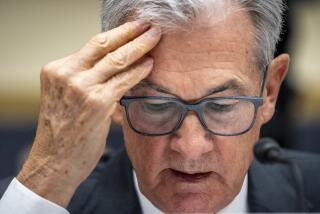1988 Economic Growth Prediction Cut to 2.4% : Administration’s Forecast, Down From 3.5%, Is Its Lowest Ever; Drop in Inflation Expected
- Share via
WASHINGTON — The Reagan Administration Wednesday sharply scaled back its expectations for economic growth in 1988 to reflect the impact of the October stock market plunge and tight monetary policy earlier this year.
The Administration released a forecast of 2.4% in inflation-adjusted growth for next year, its lowest official forecast ever and down significantly from the 3.5% rate predicted in August.
The downward revision for 1988 “is in line with many private forecasts,” said Beryl W. Sprinkel, chairman of President Reagan’s Council of Economic Advisers, emphasizing that the White House believes the economy will not be hit by a recession next year.
Unemployment Forecast
The overall unemployment rate, which could have an important effect on next November’s presidential election, was forecast to remain at its current level of 5.8% in 1988. Sprinkel predicted that the economy will add about 1.5 million jobs next year, roughly keeping pace with the expected growth in the labor force.
But the White House projected that the economic output of the nation, as measured by the gross national product, will bounce back to a strong 3.5%-growth rate in 1989. That stands in stark contrast to forecasts made by economists outside the government, many of whom are predicting a recession or very weak growth for 1989.
The latest forecast will be used in the preparation of Reagan’s fiscal 1989 budget, expected to be submitted to Congress early next year. The new economic outlook may require the White House to seek some additional spending cuts to achieve the Gramm-Rudman deficit target of $136 billion for fiscal 1989, which begins next October.
In the Administration’s economic outlook, most of the growth next year will come from a strong improvement in U.S. trade and increased business investment instead of from greater consumer spending. Until recently, consumers have provided most of the fuel to power the nation’s economic engine during this decade.
Consumer spending “is expected to grow rather slowly as households react to the stock market decline and seek to improve (their) savings rate from their recent low levels,” Sprinkel said.
He told a group of reporters that the Administration expects growth in consumer spending to contribute less than one percentage point to the expansion of the economy next year.
The White House predicted also that inflation at the consumer level, which has been running at a 4.7% rate so far this year, will fall to 4.3% in 1988 and continue shrinking in subsequent years to a 2% rate by 1993. It predicted that long-term interest rates also will fall, dropping from the 8.4% average so far this year for 10-year Treasury bonds to 8% in 1988 and as low as 4.5% by 1993.
Blue Chip Economic Indicators, a financial newsletter that surveys 51 top economists each month, says the consensus estimate is that the economy will expand at a 2% annual rate in 1988, with inflation as measured by the consumer price index at 4.2%.
Most economists, however, doubt the economy can continue to grow at the pace projected by the White House without generating strong inflationary pressures and forcing interest rates sharply higher.
Two Key Factors Cited
Sprinkel said the Administration’s forecast is dependent on two key factors in the year ahead--a continuation of growth in demand from foreign countries to help absorb rising exports from the United States and a more generous monetary policy next year under Federal Reserve Chairman Alan S. Greenspan that meets the Fed’s target of 5% to 8% growth in the broad money supply.
He contended there is nothing in the currency stabilization agreement announced Tuesday night by the United States and six other major industrial democracies that commits the Fed to raise interest rates to help support the dollar.
“There is no mention of rates, of specific levels, or of an intent to keep near present levels, in the statement,” he said, apparently contradicting another senior Administration official who insisted in a briefing for reporters Tuesday that the United States and its key trading partners are committed to preventing a further decline in the greenback.
“There is major emphasis on their determination of promoting economic policies which will promote exchange rate stability,” Sprinkel said.
The seven leading industrial nations, implying that they will make stronger efforts to intervene in foreign exchange markets, vowed to take unspecified steps to keep the dollar from fluctuating significantly against other major currencies.
Sprinkel acknowledged, though, that he was not involved in the negotiations between Treasury Secretary James A. Baker III and other economic officials abroad that resulted in the new currency agreement.
More to Read
Get the L.A. Times Politics newsletter
Deeply reported insights into legislation, politics and policy from Sacramento, Washington and beyond. In your inbox twice per week.
You may occasionally receive promotional content from the Los Angeles Times.










